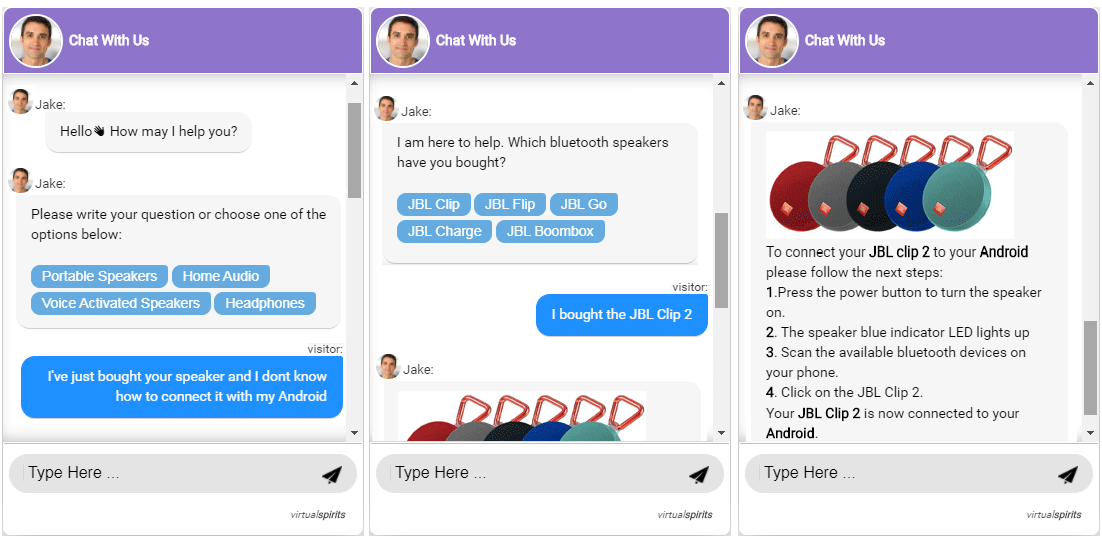
TOPICS:
Chatbot for Businesses Chatbot for Website Building a chatbot
Website Chatbot - 5 Key Elements and Examples for a Successful Chatbot
Website chatbots are becoming increasingly more popular. Over the past few years, thousands of businesses have been adding a Chatbot to their websites. A successful Chatbot can engage visitors 24/7 to help with common questions, generate leads, provide support and increase sales, without the need for a human operator. If you want to know how to build a Chatbot for your website, there are 5 key elements you should focus on in order to make it successful.

How to Build Chatbot for Website - 5 Key Elements every Website Chatbot must have
1. A “Start of Chat” that engages visitors
2. A real person behind the Chatbot
3. Answers to Frequently Asked Questions (FAQs)
4. Call-to-Action inside the Chatbot scripts
5. Chatbot optimization using real visitors' conversations
1. A “Start of Chat” that engages visitors
The first key element when building a Chatbot is having the best “Start of Chat” possible to capture the visitors' attention and get them to respond to the chat. This helps you reach out to visitors on your website and start a conversation.
As a site/business owner, you have a lot of experience talking with prospects and customers. Over time you have developed an understanding of your customers and of what works for you. You need to use this knowledge to figure out how to build a Chatbot for your website; what your visitors want when they arrive at your site; what is their motivation in visiting your site, and what may be the main obstacle holding them back in the process? Are they looking for advice, or for special deals? Do they want to talk with someone; are they looking for specific answers before they continue? A successful Chatbotengages visitors based on how they see the world rather than on how you want to convert them.
Building a Chatbot for your Website - A few tips that can help you set up your ChatbotChat window settings - When building a Chatbot for your website choose colors that will make the chat window stand out and add your logo to the chat window. Pick your timing carefully; don't set triggers that popup immediately, but don’t wait till they're gone either.
Short welcome sentence - Start with a short sentence welcoming the visitor to your site. For instance, "Welcome to ABC consulting. How may I help you?". This signals to the visitors that there is a conversation being initiated, and not a static popup or advertisement.
Open questions - Add a sentence in the form of an open question that mirrors the motivation of your visitors. The aim is to stop visitors from leaving the site and to focus on their need. If you know that most of your customers want help before they order, you may say something like, "Are you looking for advice before making an order?". If you know people are looking for a solution to a problem you may say, "What is the problem you need help with?", etc.
Call-to-action - If your goals fit the visitors' view then you may use it when creating the Chatbot for your website and add a Call-to-Action in the start of the chat. This works well because visitors are more focused in a chat than on a page full of content. So, if you add a sentence that says "We recommend signing up to have a quote sent to you”, most visitors will focus on that and understand what they need to do. They may still have questions, but they are already focused on the next stage, i.e. signing up to get a quote.
2. Real person behind the Chatbot
A common misconception is that when building Chatbots for websites they have to look and feel like robots. In reality we find that Chatbots are more successful when visitors understand that a real person is behind it.
Using a real person as a representative is the second key element when building a Chatbot for website.
• Add an image of a real person that works in the company
• Use their real name
• Consider adding a link to the Facebook/LinkedIn page if this fits your company's style.
• Don't use stock photos, or reps with headsets.
• Use a real profile kind of picture
By doing this, you signal that answers in the chat are real because they were written by a real person, versus a robot. Visitors understand that someone is actually reading their messages. And they understand that when they leave their contact details they are more likely to have someone get back to them than when leaving a message in a form. This gives you the opportunity to better deliver your messages, and better connect with prospects.
3. Chatbot Answers to Frequently Asked Questions (FAQ)
The third key element when building a Chatbot for website is to have the best answers possible to a large number of frequently asked questions, gathered by real visitors' questions.
Visitors have questions that hinder the process, and these need to be handled in order to continue. It is very natural for them to ask these questions inside a chat forum. This is a great opportunity to help visitors with instant answers that will strengthen their motivation, remove obstacles, and solves issues online.
Successful Chatbots can have 100-200 answers to frequently asked questions. Use the following tips when you build a chatbot for your website:
• Add answers to new questions as your visitors ask. Re-use the visitors’ real questions/words as a short title for the FAQs.
• Try to find the best responses to common questions and keywords that visitors are using most often. The best response is the optimal answer that helps your visitors, increases motivation, and gets you closer to your goals.
• In order to help your visitors when creating your chatbot, , it is recommended that you provide information as well as personal tips/advice. If detailed information is on the website, you can include a link to the page as well.
• When relevant, you can add images or videos in your answers.
• Improve existing answers based on visitors' feedback and chat outcomes, i.e. did you reach your goals?
Here is an example of a Chatbot for self-service support conversation:
Visitor: What does it cost? Chat: Click here to visit our pricing page. As you can see we provide 3 different plans. Typical costs range between $15USD-$85USD per month. Is there anything else I can help you with today?
Here is an example of a Chatbot for lead generation conversation:
Visitor: What does it cost?Chat: Click here for all our prices. We can help you find the right package for your needs and we have last minute deals that may be relevant to you. Please provide your email address and we will get back to you with current offers.
4. Call-to-Action inside the Chatbot scripts
Using the call-to-actions the same way you would use them in a normal conversation is the fourth key element when building a Chatbot for website.
Some of the most popular goals are lead generation, online registrations, online sales, and self-service support. In order to achieve your goals, when creating a chatbot for your website, you will need to change the chat scripts with call-to-actions that will drive visitors in that direction. Reading chat history is a great way to quickly see where sentences need to be changed. Do not place call-to-actions randomly inside the conversation.
For instance, if you're building a chatbot for website with a goal of generating leads then right after answering a question your chat script could say "I recommend discussing this with one of our representatives. If you will provide me with your email address, we will get back to you with more details as soon as possible."
On the other hand, if you're creating a chatbot for website with a goal of increasing signups of your free trials you could say "The best wat to understand how we can benefit your business is to give it a try. We offer a free trial. Click here to get started."
5. Chatbot optimization using real visitors' conversations
The last key element for a successful Chatbot is optimization based on real visitors’ conversations. This is a key benefit of the Chatbot that only becomes apparent after time for most users. The ability to read visitors' conversations in order to capture valuable information about your visitors’ views, motivations, obstacles, and responses to your messages is invaluable.
Web professionals are used to the processes of checking PPC performance, Google Analytics, researching keywords, A/B testing pages, etc. Creating a Chatbot for website offers a whole new source of information which is particularly effective because it deals with visitors to the website and provides feedback in the visitors' own words, which is highly actionable.
Successful Chatbot users are utilizing this information to add new answers, improve exiting answers, and to modify call–to-actions or even entire Chatbot scripts. They can go as far as feeding this information back into the website's design, their product design or the company's strategy.
In Summary
These are the 5 key elements every Chatbot must have to be successful on any website. Some of these key elements may seem trivial, while others are unique to the field of Chatbots. Focus on these 5 key elements when creating a Chatbot for your website, use real visitors' conversations as feedback and insights, and you'll be on the right path to success.